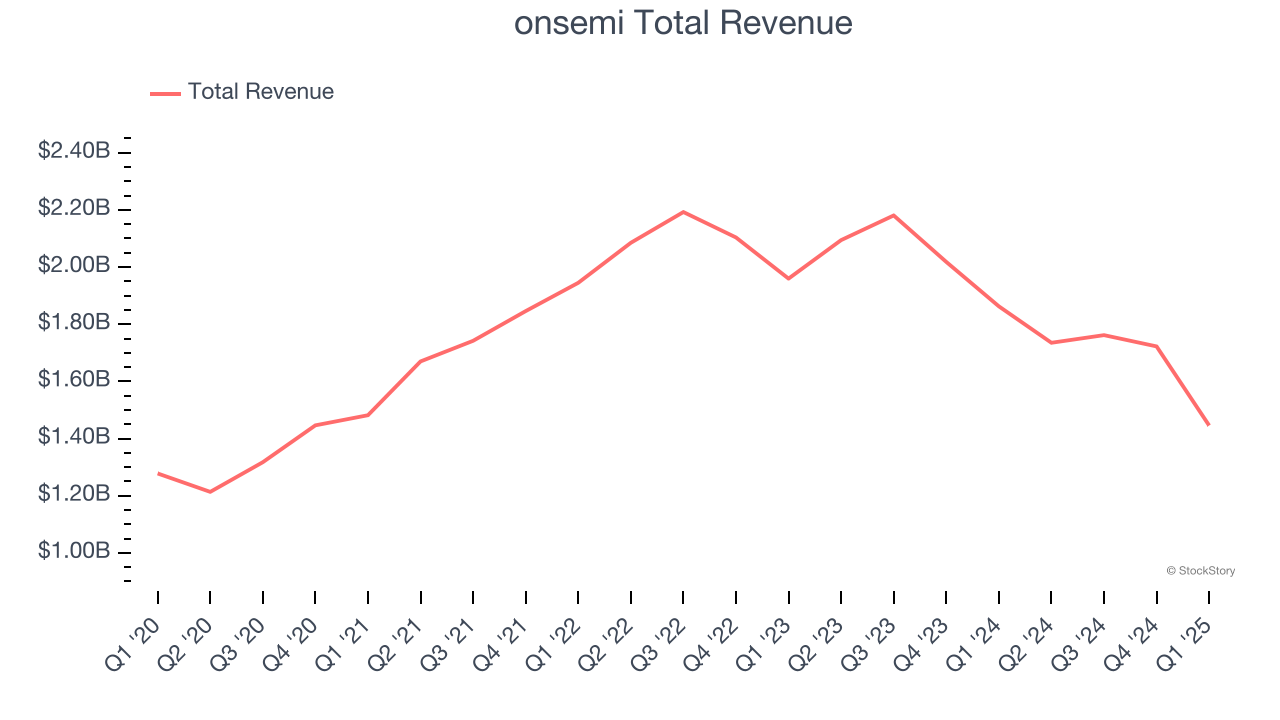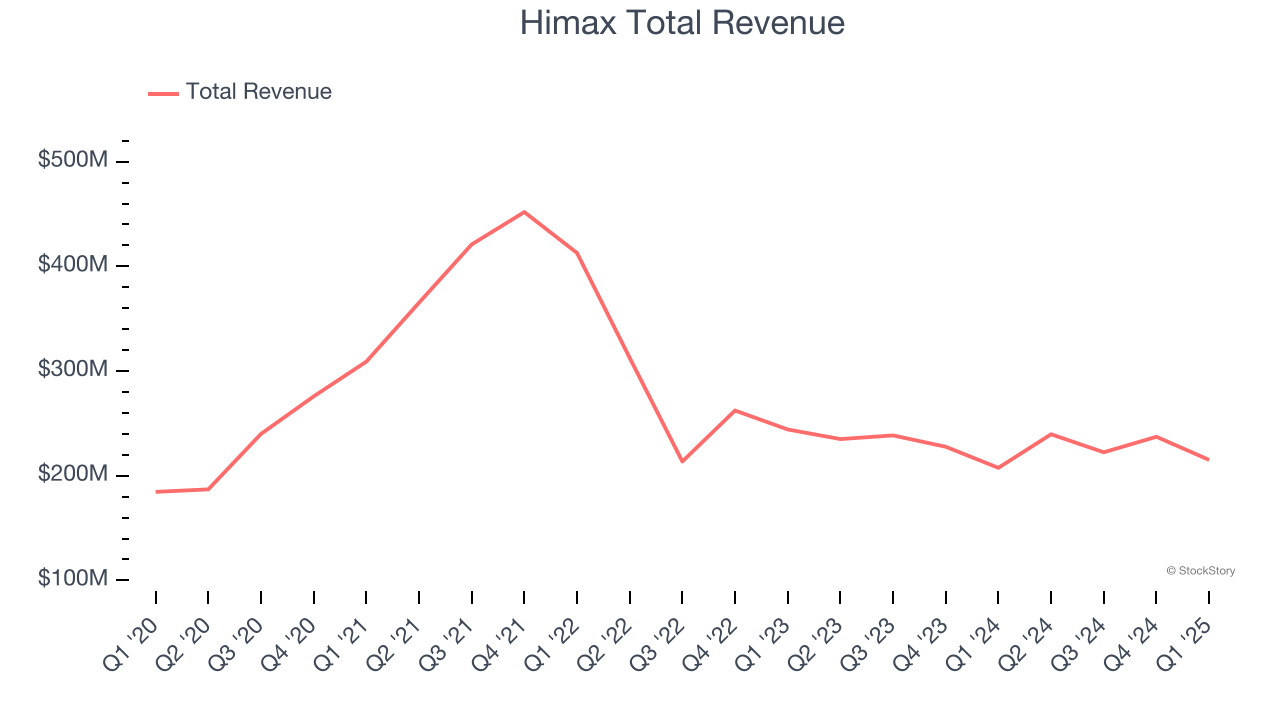![]()
Earnings results often indicate what direction a company will take in the months ahead. With Q1 behind us, let’s have a look at onsemi (NASDAQ: ON) and its peers.
Demand for analog chips is generally linked to the overall level of economic growth, as analog chips serve as the building blocks of most electronic goods and equipment. Unlike digital chip designers, analog chip makers tend to produce the majority of their own chips, as analog chip production does not require expensive leading edge nodes. Less dependent on major secular growth drivers, analog product cycles are much longer, often 5-7 years.
The 15 analog semiconductors stocks we track reported a strong Q1. As a group, revenues beat analysts’ consensus estimates by 2.2% while next quarter’s revenue guidance was 0.9% above.
Luckily, analog semiconductors stocks have performed well with share prices up 19% on average since the latest earnings results.
onsemi (NASDAQ: ON)
Spun out of Motorola in 1999 and built through a series of acquisitions, onsemi (NASDAQ: ON) is a global provider of analog chips specializing in autos, industrial applications, and power management in cloud data centers.
onsemi reported revenues of $1.45 billion, down 22.4% year on year. This print exceeded analysts’ expectations by 3.1%. Overall, it was an exceptional quarter for the company with a significant improvement in its inventory levels and an impressive beat of analysts’ EPS estimates.
“Our results in the first quarter reflect the disciplined approach we have maintained through this downturn – managing our cost structure, right-sizing our manufacturing footprint, and rationalizing our portfolio – enabling us to generate increased free cash flow. We are committed to long-term value creation and we are accelerating our capital return to shareholders while investing in our future growth,” said Hassane El-Khoury, president and CEO, onsemi.

The stock is up 28.4% since reporting and currently trades at $53.84.
Is now the time to buy onsemi? Access our full analysis of the earnings results here, it’s free.
Best Q1: Himax (NASDAQ: HIMX)
Taiwan-based Himax Technologies (NASDAQ: HIMX) is a leading manufacturer of display driver chips and timing controllers used in TVs, laptops, and mobile phones.
Himax reported revenues of $215.1 million, up 3.7% year on year, outperforming analysts’ expectations by 2.4%. The business had an exceptional quarter with a solid beat of analysts’ EPS estimates and revenue guidance for next quarter exceeding analysts’ expectations.

The market seems happy with the results as the stock is up 19.3% since reporting. It currently trades at $8.90.
Is now the time to buy Himax? Access our full analysis of the earnings results here, it’s free.
Weakest Q1: Vishay Intertechnology (NYSE: VSH)
Named after the founder's ancestral village in present-day Lithuania, Vishay Intertechnology (NYSE: VSH) manufactures simple chips and electronic components that are building blocks of virtually all types of electronic devices.
Vishay Intertechnology reported revenues of $715.2 million, down 4.2% year on year, falling short of analysts’ expectations by 0.6%. It was a slower quarter as it posted a significant miss of analysts’ EPS estimates and revenue guidance for next quarter meeting analysts’ expectations.
Vishay Intertechnology delivered the weakest performance against analyst estimates in the group. Interestingly, the stock is up 14.6% since the results and currently trades at $15.39.
Read our full analysis of Vishay Intertechnology’s results here.
Texas Instruments (NASDAQ: TXN)
Headquartered in Dallas, Texas since the 1950s, Texas Instruments (NASDAQ: TXN) is the world’s largest producer of analog semiconductors.
Texas Instruments reported revenues of $4.07 billion, up 11.1% year on year. This number surpassed analysts’ expectations by 4.1%. Overall, it was a very strong quarter as it also recorded a solid beat of analysts’ EPS estimates and an impressive beat of analysts’ adjusted operating income estimates.
The stock is up 33.9% since reporting and currently trades at $203.39.
Read our full, actionable report on Texas Instruments here, it’s free.
Analog Devices (NASDAQ: ADI)
Founded by two MIT graduates, Ray Stata and Matthew Lorber in 1965, Analog Devices (NASDAQ: ADI) is one of the largest providers of high performance analog integrated circuits used mainly in industrial end markets, along with communications, autos, and consumer devices.
Analog Devices reported revenues of $2.64 billion, up 22.3% year on year. This result topped analysts’ expectations by 5.2%. It was a very strong quarter as it also produced a solid beat of analysts’ EPS estimates and an impressive beat of analysts’ adjusted operating income estimates.
The stock is up 5.3% since reporting and currently trades at $233.77.
Read our full, actionable report on Analog Devices here, it’s free.
Market Update
Thanks to the Fed’s rate hikes in 2022 and 2023, inflation has been on a steady path downward, easing back toward that 2% sweet spot. Fortunately (miraculously to some), all this tightening didn’t send the economy tumbling into a recession, so here we are, cautiously celebrating a soft landing. The cherry on top? Recent rate cuts (half a point in September 2024, a quarter in November) have propped up markets, especially after Trump’s November win lit a fire under major indices and sent them to all-time highs. However, there’s still plenty to ponder — tariffs, corporate tax cuts, and what 2025 might hold for the economy.
Want to invest in winners with rock-solid fundamentals? Check out our Top 6 Stocks and add them to your watchlist. These companies are poised for growth regardless of the political or macroeconomic climate.





